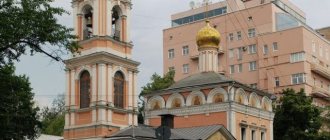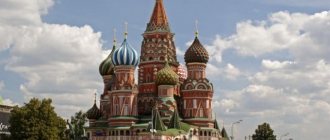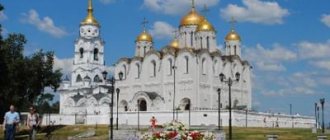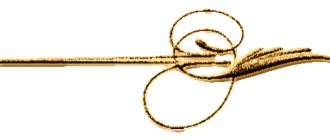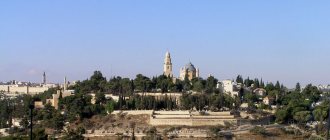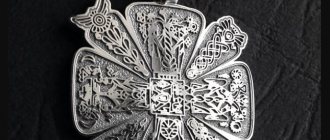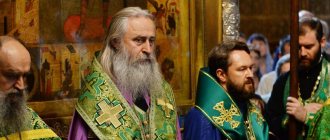Moscow is one of the most ancient cities in Russia, so it is not at all surprising that various holy places are concentrated in the territory of the city and region. There are real legends about these famous shrines, so a very large number of people go to these places in order to pray, gain vital strength or worship the great saints.
In general, all over the world, for decades and even hundreds of years, there have been debates about holy places, whether they really have any specific healing power or whether it is all the power of psychological suggestion of the people themselves.
It’s a personal matter for everyone to believe or not, but it’s very difficult to argue with the fact that in the Moscow region and Moscow there are real holy places that have healing powers. It is to these shrines that people come not only from other cities and neighboring regions, but also from other countries.
There are a total of one hundred holy and healing springs on the territory and in the nearest cities of the Moscow region, but not everyone is in demand among tourists, although every year local pilgrimage becomes more and more popular. Find out about some of the most famous holy places in Moscow and the Moscow region - you might want to make a pilgrimage in 2021.
Conception Convent
Where : St. m. “Park Kultury”, 2nd Zachatievsky lane, 2. What : Icon “Merciful”. History : Copy from an icon created according to legend by the holy evangelist Luke. The original, which is kept on the island of Cyprus in the Kykkos monastery, has a peculiarity - no one can see it. Anyone who dares to lift the veil with which he is covered will face God's punishment. What they pray for : Before this image they ask for the gift of children and relief from headaches.
Excursions around Moscow and surrounding areas
Moscow is one of the leaders in the number of excursions on Tripster (also in the number of positive reviews). Sightseeing routes, quests for children and adults, excursions to museums, estates and parks - choose from more than 100 options!
Of course, there are still a lot of Orthodox churches in Moscow, but a tourist should visit at least these six attractions to get a general idea of Russian Christian shrines.
Petrovsky Traveling Palace - how to get there, Tsaritsyno Park in Moscow and the Kolomenskoye estate - excursions 2021. The best hotels in Listvyanka, as well as Baikal resorts 2021. All about the Kaliningrad region, apartments and hotels in Kaliningrad.
Cathedral of Christ the Savior
Where : St. m. "Kropotkinskaya", st. Volkhonka, 15. What : A piece of the robe of the Blessed Virgin Mary. History : According to legend, the robe of the Virgin Mary was stolen in Nazareth by the Byzantine brothers Galvin and Candide from the house of an elderly Jewish woman. She was a descendant of one of the women to whom the Virgin Mary herself gave the robe. The particle came to Russia thanks to Dionysius of Suzdal, who bought it in Constantinople. After the revolution, it was kept in the storerooms of the Moscow Kremlin, from where in 2008 it was transferred to the Russian Orthodox Church by Dmitry Medvedev. What they pray for : Helps repel the invasion of enemies, and also pray for the health of children.
The most revered relics of saints in Moscow
1. Relics of Saint Matrona of Moscow. They ask her for healing from illnesses, and for pregnancy, and for admonition. It is also believed that Matrona herself knows who and what to give. Pokrovsky Stavropegial Convent - st. Taganskaya, 58, st. m. "Marxists".
2. “Kiyan cross” with particles of the relics of more than 100 saints: John the Baptist, the prophet Daniel, the apostles Paul and James, the brother of the Lord, the evangelists Luke and Matthew, Equal-to-the-Apostles King Constantine. The reliquary, made to the size of the Cross of the Lord, was made with the blessing of Patriarch Nikon - in memory of salvation from a shipwreck on the White Sea. Temple of St. Sergius of Radonezh - Krapivensky lane, 4, st. metro stations "Trubnaya", "Chekhovskaya".
3. Particles of over 150 saints of God in arks and icons. Church of the Martyr John the Warrior - st. B. Yakimanka, 46, st. m. "Oktyabrskaya".
4. Reliquary with part of the rod of Moses . The same one that turned into a snake (and back) and absorbed the wands of Egyptian sorcerers. It was lost many centuries ago, and how a piece of it got into the Moscow temple is a mystery. Church of the Assumption of the Virgin Mary - st. Goncharnaya, 29, st. m. "Taganskaya".
5. Arks for 100 and 50 relics . Among them is St. Great Martyr Catherine, Andrei Bogolyubsky, Apostle Andrew the First-Called and others. Church of the Venerable Zosima and Savvaty of Solovetsky Wonderworkers - st. Baikalskaya, 37a, st. m. "Shchelkovskaya".
6. Relics of St. Nicholas . One of the most beloved Orthodox saints, people turn to him with various requests - from the most serious, health-related, to momentary, everyday ones. Church of St. Nicholas on the Three Mountains - Novovagankovsky lane, 9, art. m. "Krasnopresnenskaya".
7. Reliquary arks with particles of the holy relics of the venerable fathers of the Kiev-Pechersk, with particles of the Robe of the Lord, the Robe of the Mother of God, the Life-giving Cross of the Lord. Particles of the relics of the holy apostles and Russian saints are also kept there, including the high priests of Moscow, St. Seraphim of Sarov, Cyril and Mary of Radonezh, the venerable Optina elders, St. Basil the Blessed. Novospassky Stavropegic Monastery - Krestyanskaya Square, 10, Art. m. "Peasant Zastava".
8. Reliquary cross with particles of the relics of St. Nicholas, St. Sergius of Radonezh, St. Andrew of Crete, a piece of the Holy Sepulcher, the tomb of the Mother of God and the Life-giving Cross of the Lord. Church of the Ascension of the Lord on Gorokhovoy Pole - st. Radio, 2, st. m. "Baumanskaya".
9. Relics of the Blgv. book Dimitry Donskoy . This saint should be prayed for to preserve faith, moral purity, determination, and courage. Cathedral of the Archangel Michael (Archangel Cathedral of the Kremlin) - Kremlin, Cathedral Square, Art. m. "Borovitskaya".
10. Relics of Moscow metropolitans . In the northern aisle rest the relics of St. Peter of Moscow, with whose blessing the Assumption Cathedral of the Kremlin was founded in August 1326. The temple also contains the relics of the Russian patriarchs Job and Hermogenes. Patriarchal Cathedral of the Dormition of the Blessed Virgin Mary - Kremlin, Cathedral Square, Art. m. "Borovitskaya".
11. Particle of the relics of St. Andrew the First-Called . He was the first of the apostles to follow Christ, and then brought to him his brother, the holy Apostle Peter. They pray to him for all sorrows. Cathedral of Christ the Savior - st. Volkhonka, 15, st. m. "Kropotkinskaya".
12. A piece of the relics of the great martyr. St. George the Victorious .
Patron of the Orthodox army, as well as Moscow. Church of St. George the Victorious on Poklonnaya Hill - pl. Pobeda, no. 36, st. m. "Kutuzovskaya".
Church of St. Nicholas in Tolmachi
Where : St. metro station "Tretyakovskaya", Maly Tolmachevsky lane, 9. What : Vladimir Icon of the Mother of God. History : According to legend, it was written by the Evangelist Luke during the earthly life of Jesus and the Mother of God on a board from the table at which the Savior had a meal with the Most Pure Mother and Righteous Joseph. The Mother of God, seeing her image, said: “Let the grace of the One born of Me and Mine be with this icon.” What they pray for : For protection from various ailments.
Help for the childless
There are also plenty of holy places in Moscow that can help you get pregnant. Both parents can pray for the baby. For example, in the Cathedral of John the Baptist on Presnya there is an icon of the Nativity of John the Baptist. Believers advise the man to venerate the shrine and sincerely ask for an addition to the family.
The Holy Matronushka helped many women become pregnant. To venerate the relics of the blessed Matrona of Moscow, they go with flowers and gifts to the Intercession Monastery on Taganka. Her miraculous icon is also located here. The saint can also be prayed for healing and marriage.
They go to the Intercession Monastery with flowers and gifts to venerate the relics of the blessed Matrona of Moscow,
They first write a note to her and leave it in the temple, and then there is a long line, because there are always enough people who want to worship the Saint. Many believers go to the Danilovskoye cemetery, where Matrona was buried more than half a century ago.
The name of the Conception Monastery speaks for itself. This is a place of power that helps women get pregnant, carry and give birth to a healthy baby. Here believers pray to the icon of the Mother of God, or the relics of Saints Joachim and Anna.
You can also beg for a child from the Mother of God, from the miraculous icon Helper in Childbirth
You can also beg for a child from the Mother of God, from the miraculous icon of the Helper in Childbirth. She has already helped many infertile women realize their dream and give birth to a baby. In Moscow, the icon is in the Church of the Transfiguration on Bolvanovka.
Temple in honor of the position of the Honest Robe of the Lord on Donskaya
Where : St. m. "Shabolovskaya", st. Donskaya, 20/6, p. 1. What : Analog icon “The position of the Robe of the Lord in Moscow” with a particle of the Robe of the Lord. History : The image was transferred to the temple from the Assumption Cathedral of the Kremlin by Patriarch Alexy I on the 250th anniversary of the founding of the church. The Persian Shah Abbas, at the insistence of the Russian ambassador, sent the robe of Christ to Tsar Mikhail Feodorovich in 1625. What they pray for : They turn to Jesus with a plea for intercession and help.
Relics of the Righteous Prince Dmitry Donskoy
Prince Dmitry Ioannovich Donskoy is considered one of the most important patrons of the capital. He went down in history as the great Russian prince, the conqueror of the Horde, the defender of the faith and the builder of the white stone Moscow Kremlin. Numerous legends tell of him as an exemplary family man, an unusually righteous and pious person, a true Christian. For descendants, Prince Dmitry became an example of a valiant and courageous defender of the Russian land, and in 1988 he was canonized by the Local Council of the Russian Orthodox Church. Long before his canonization, he was considered the patron saint of Moscow and an ideal for many Russian rulers. The holy relics of Dmitry Donskoy are kept in the Archangel Cathedral of the Kremlin along with the remains of members of his family.
John the Baptist Convent
Where : St. m. "Kitai-Gorod", Maly Ivanovsky lane, 2. What : Icon of the Prophet, Forerunner and Baptist of the Lord John with a particle of relics. History : Jesus Christ, speaking about John, praised him like no other: “Truly I say to you, among those born of women there has not arisen a greater one than John the Baptist.” Following the Mother of God, she is considered the main petitioner before God for the believers. What they pray for : They ask for relief from headaches and ask for fertility.
Relics of St. Sergius of Radonezh
St. Sergius of Radonezh is a miracle worker and perhaps the most revered saint of the Russian Orthodox Church. His role as an ascetic of Christianity was so great that in the middle of the 20th century even the Roman Catholic Church canonized him. Saint Sergius founded many monasteries (including the Trinity-Sergius Monastery, a stronghold of Russian spirituality) and inspired a galaxy of church leaders. It is difficult to overestimate his contribution to the unification of Russian lands. Miracles of healing and resurrection, reconciliation of warring parties and miraculous visions are associated with the name of the saint. He was canonized half a century after his death. The holy relics of Sergius of Radonezh rest in the Trinity-Sergius Lavra, where anyone can venerate them. As a miracle worker, they pray to him for healing, as a peacemaker - to pacify pride, as a defender of the righteous - they ask for protection on the eve of a lawsuit. According to legend, St. Sergius miraculously learned to read and write, and therefore he is also asked for help in comprehending the sciences.
Assumption Cathedral of the Moscow Kremlin
Where : St. metro station "Borovitskaya", Kremlin, Sobornaya sq. What : Nail of the Lord and staff of St. Peter, Metropolitan of Kiev and All Russia, tomb of the primates of the Russian Church. History : One of the four Nails with which the Lord was crucified on the Cross on Good Friday. There is still no trace of rust on it; it is black in color with rare golden splashes. Brought to Russia by the Georgian Tsar Archil Vakhtangovich, who moved to Moscow during the time of Peter I. What they pray for : Before him they praise and thank the Lord for his sacrificial deed.
Ark with a piece of the belt of the Blessed Virgin Mary
Celebration: 31
/ September 13
HISTORY OF THE HOLIDAY
The Belt of the Blessed Virgin Mary is one of the greatest shrines associated with the life of the Blessed Virgin. According to legend, She Herself wove it from camel hair and wore it until Her Dormition.
The heirs of two widows who received the belt from the Mother of God, the shrine was passed down from generation to generation, and from the 4th century it was in Constantinople, enclosed in a golden ark with the royal seal and placed in the Blachernae temple.
During the reign of Emperor Leo the Wise (886–911), his wife Zoe was healed by laying on the belt of the Mother of God. Zoya, who was suffering from an unclean spirit, had a vision of her liberation from her illness through the belt of the Most Pure One. At the request of the emperor, the Patriarch removed the seals, opened the ark with the shrine and placed it on the sick woman, who was immediately healed.
The belt of the Mother of God turned out to be completely preserved, untouched by time. After the thanksgiving service, it was sealed again and placed in the Blachernae Church. And in memory of the miracle that occurred and the double position of the honorable belt, the Feast of the Position of the Honorable Belt of the Blessed Virgin Mary was established.
In the 10th century, the belt, already famous for its miracles, was divided into parts. One of them is now kept on Mount Athos, in the Vatopedi monastery. In 2011, on the initiative of the St. Andrew the First-Called Foundation, the belt was brought to Russia. The shrine visited 14 cities and the Seraphim-Diveevsky Monastery. More than three million pilgrims bowed to her.
The belt of the Most Holy Theotokos has returned to Athos, but worship of this shrine continues in Moscow. The stream of believers who want to pray for themselves and their loved ones does not stop coming to the Obydensky Church, where a piece of the belt is kept. Orthodox families without children place special hope in the help of the Mother of God. The Most Pure One saves women from infertility and bestows the joy of motherhood.
TROPARION, tone 8
In the Ever-Virgin Virgin Mary, the covering of men, / the robe and girdle of Your most pure body, / You bestowed a sovereign tax on Your city, / Your seedless Nativity is incorruptible, / about You For both nature and time are renewed. / We also pray to You to grant peace to Your city // and great mercy to our souls.
IN TROPARION, tone 5
I am inconspicuously rich, / Thy honorable belt, Ever-blessed One, / and possessor of good gifts, / The monastery of Vatopedi calls upon Thee, / girding ourselves with reverence / flowing to him / by his divine power / and destroy the fortress of the flattering enemy, // pure salvation for the faithful.
PRAYER
O Most Holy Lady Lady Theotokos, you are the highest Angel and Archangel of all and all the most honest creatures, you are the Helper of the offended, the hopeless, the intercessor of the poor, the consolation of the sad. feeding, nurse of the hungry, clothing of the naked, healing of the sick, salvation of sinners, help and intercession for all Christians. O All-Merciful Lady, Virgin Mother of God Lady, by Your mercy save and have mercy on the Great Lord and Father of our (name) His Holiness Patriarch of Moscow and All Russia, and His Holiness Patria Orthodox bishops, and eminent metropolitans, archbishops and bishops, and the entire priestly and monastic rank, God-protected country our Russian city, this city, its power and armies, and all Orthodox Christians through the robe of Your honest protection, and begged, Lady, from You, without seed, the incarnate Christ our God, may he gird us with His power from above, against our invisible and visible enemies. O All-Merciful Lady Lady Theotokos, raise us from the depths of sin and deliver us from famine, destruction, from cowardice and flood, from fire and sword, from the presence of foreigners and internecine warfare, and from the dreams of death, and from the attacks of the enemy, and from the harmful winds , and from deadly ulcers, and from all evil. Grant, Lady, peace and health to Your servants, all Orthodox Christians, and enlighten their minds and eyes of the heart, even to salvation; and are we, Thy sinful servants, worthy of the Kingdom of Thy Son, Christ our God, for His power is blessed and glorified, with His Beginning Father, and with the Most Holy, and Good, and Life-Giving by His Spirit, now and ever, and unto ages of ages, amen .
Epiphany Cathedral in Yelokhov
Where : St. m. "Baumanskaya", st. Spartakovskaya, 15. What : Icon of the Mother of God “Mammal”. History : The only Orthodox icon depicting the Mother of God nursing the Divine Child. The first list appeared in a monastery founded by Sava the Sanctified near Jerusalem, a stronghold of severity and chastity. The icon fed the monks with spiritual wisdom. What they pray for : Patroness of women in labor and nursing mothers.
Holy springs in the Moscow region
Not far from the city of Sergiev Posad there is the monastery of St. Sava with a healing holy spring. The spring has several baths for women and men;
- The holy spring “Kolotsky”, located on the territory of the Assumption Convent, is known to many pilgrims. You cannot plunge into its waters, you can douse yourself next to the spring, the water from it is pleasant and soft to the taste, the grace of God is felt in everything;
- spring "Gremyachiy Klyuch" near the city of Sergiev Posad. Tradition says that the key was hammered during the prayer of St. Sergius of Radonezh for the unification of Russian lands in this place. Spring water contains a rich complex of minerals, which has been confirmed by several laboratory studies. At the source you can plunge into the font, you can douse yourself under the keys, and take holy water with you on the road.
Water from the source of St. Nicholas the Wonderworker helps to heal spiritual wounds and add strength to strengthen faith in the Lord.
Moscow Bermuda
When they talk about places of power, with positive or negative energy, they usually mean that such places are few and far between. However, apparently, reality shows that in fact there are a huge number of places of power and they occur much more often than one might think. In this article we will talk only about a small part of such places of power in Moscow.
Moscow Bermuda
People have always been interested in places of power. Some places are considered bright, beneficial and healing. Other places are called dismal and dark. In a positive place of power, a person feels good and calm, and there is a feeling of a surge of vigor and strength. In a negative place of power, a person often feels uneasy; many feel like energy and strength are leaving them, the nervous system is depressed.
In rock faults in the earth's crust, hot magma, as a carrier of colossal energies, comes very close to the surface of the planet. This causes the presence of magnetic bursts and anomalies in many places on Earth. These points are called geoactive or power points. It is in them that various natural phenomena and anomalies are observed.
According to the hypothesis of the West German scientist E. Hartmann, the earth is divided into “sick” and “healthy” zones. This is the so-called geopathy, caused by the existence of a geobiological network called the “Hartmann network”. Radiation from groundwater, interacting with the physical fields of the Earth and with streams of charged cosmic particles, leads to the appearance of an invisible to the eye, but detectable by radioesthetists and their instruments, “Hartmann network” on the earth’s surface, “threads” up to 20 centimeters thick, intersecting, forming particularly pathogenic "knots".
According to some experts, “pathogenic nodes” are unique acupuncture points of the Earth, through which energy and information are exchanged between Space and Earth. Between the “threads” of the pathogenic network are cells measuring approximately 2 by 3 meters, which can be characterized as zones relatively favorable for the presence of living organisms in them. These “threads” are located in the directions north-south and west-east, like parallels and meridians. “Sick” zones are places where threads intersect. The nature of magnetic radiation has not yet been clarified, but, according to some scientists, it has a harmful effect on people’s health, performance and life expectancy. It is especially undesirable for a person to stay for a long time in such areas where “threads” intersect.
The Moscow landscape is a hilly area crossed by many rivers. If you superimpose Hartman’s network on the physical map of Moscow, you can see strange things - some “sick zones” will coincide with the features of the landscape and thus intensify many times over.
There are well-known places of power in Moscow - Red Square, Neskuchny Garden, Sparrow Hills, Poklonnaya Hill. There are lesser-known places - Kolomenskoye, Kuzminki, Tsaritsyn Kurgans, a hill in Kotelnichesky Lane with an old oak tree and a bent birch tree at the intersection of Polyanka and Yakimanka.
Poklonnaya Hill in Moscow
At one time in Moscow there were many ravines (most of them are filled in today), there were rivers (now they flow in pipes) - these are negative places of power, they take away energy. There are also positive places of power that give energy: in Kitay-gorod, in Zaryadye, in other places where Vedic sanctuaries were located in ancient times.
Place of power - Zaryadye Park
“Friendly” places have always been chosen for the construction of churches. They could be detected by observing the behavior of animals. The existence of “bad” places was associated with supernatural forces. “Bermuda triangles”, dangerous for people, exist in different places in Moscow, and, as a rule, they are located on the site of devastated cemeteries, places of massacres and burials. Expanding, the metropolis is “advancing” on burial sites. During the period of mass construction in Moscow, a large number of cemeteries were destroyed. At this time, the cemetery of the Alekseevsky Monastery, the Dorogomilovsky cemetery, the Armenian cemetery in Gruziny, and two Semenovsky cemeteries ceased to exist. The Fraternal Military Cemetery on Novopeschanaya Street, opened during the First World War, etc., was demolished. Our ancestors knew from their own experience that the destruction of a graveyard could bring disaster to the living.
Monument over the mass grave of soldiers who died in 1812. Dorogomilovskoe cemetery, 1947-1950.
On their part, we expect the opposite impact in the form of a negative impact on the residents of new buildings built on “places of oblivion.” In high-rise buildings located on former cemeteries, residents get sick more often than in neighboring buildings. Mental discomfort, fatigue syndrome and depression indicate the presence of a necrotic spell. And the routes passing through devastated cemeteries are characterized by an increased accident rate.
Quarter of Stalinist houses on the site of the cemetery
The largest anomaly is considered to be a tectonic fault running from northwest to southeast and almost coinciding with the bed of the Moscow River. The rift divides the city into two parts. Moreover, to the north of the fault there are tens of times more people with mental problems than to the south. The fault runs from Ostankino to the intersection of Leningradsky Prospect and Begovaya Street. The other, from Izmailovsky Park to Poklonnaya Gora, runs through Zamoskvorechye and Gagarin Square. Experts classify Kolomenskoye, Losiny Ostrov, Maryina Roshcha, and Tsaritsyno as disadvantaged areas. They also claim that in Moscow for a long time there have been bans on the construction of housing in the Teply Stan area.
Map of geological risks of Moscow
In dangerous places, in addition to poor sleep and headaches, there are often hallucinations. Children sleeping in such places often sleepwalk. Moreover, not only people feel bad, but also the homes themselves. Cracks appear, buildings collapse and explode. Here are a few such examples.
December 25, 1967 on the street. Osipenko, 77, apt. 1, two powerful explosions occurred one after another. The five-story building collapsed, turning into a pile of rubble. According to eyewitnesses, the house rose above the ground, hovered and only then collapsed. Gravity disappeared for a few minutes. 200 people died. One of the residents was somehow thrown back onto the Krasnokholmsky Bridge without receiving any damage.
And in 1997, a strange earthquake occurred on the Enthusiasts Highway. The gas pipeline is broken. According to eyewitnesses, some cars were thrown into the air to the height of a five-story building. An equally mysterious earthquake occurred in the Lefortovo area. For an hour, chandeliers swayed and dishes clinked in houses located on Borovaya, Ukhtomskaya and Gospitalny Val streets. It was as if some evil force had cut off the sewer pipe. It’s interesting, but sensitive devices “slept through” this mysterious phenomenon.
There are also “unclean” places in the capital, which not only priests, but also police officers advise avoiding. No one can explain the tragic events that happen in such zones with enviable consistency.
Strange intersection
Near Chistye Prudy at the intersection with Pokrovka there is a house that some people cannot pass by - they fall dead. They say that the place is really strange, and people, at first glance, healthy and full of life, fell dead there, just passing by. The doctors who took people from there were unable to save anyone; they either died on the spot or on the way to the hospital. For people who died at that place, pathologists cannot establish the true cause of death, so they diagnose AHF (acute heart failure).
The doctor who told this story never appeared at that place again and avoided him. In spring this place is especially attractive and beautiful, but it is “dead”.
The original name of Chistye Prudy was Pogannye Prudy. There are several versions of why they received such a dissonant name. Perhaps the name comes from “paganus” - “pagan”. There is an opinion that this name originated during the birth of Moscow. There was a village in this place. It belonged to the boyar Stepan Kuchka. Prince Yuri Dolgoruky, angry at the poor reception of the boyar, ordered to kill Kuchka and throw his body into the pond, after which the pond began to be called Pogany. But some sources claim that previously there was a stream in this place and people took water from it for drinking. But then, strange phenomena began to occur near the stream, children disappeared. There are also references to the fact that a strange creature was seen in those places... Residents stopped taking water from the stream and preferred to fill it with garbage and sewage. Over time, the stream turned into a swamp. And only after a long time, the favorite of Peter I, Alexander Menshikov, ordered the stream to be cleaned and the name Pogany turned into Chisty.
Failed Monastery
In the area of modern Tushino in the 14th century, the Spaso-Preobrazhensky Monastery stood on the holy mountain. According to an old legend, visiting merchants once asked the monks to stay for the night. But they didn’t let them in. The next morning, the merchants were found in a grove, not far from the monastery walls, “beaten and without goods.” And then one surviving merchant wished the monks to “fail.” Since then, the monastery land in the vicinity of the Old Mountain began to settle, and no matter what people built here, everything went to dust. According to legend, it was in this place that the camp of the Tushino thief once stood. Now this place looks like a hole from a meteorite fall. The residents of the surrounding houses tried to set up vegetable gardens here, but they abandoned it. At one time, hang gliders chose this mountain for their flights. Yes, too, then they left: there were too many injuries.
Bermuda roads in Moscow
Moscow highways also have their own “cursed” places. The Moscow traffic police has published a list of the most problematic intersections in the city. At the same time, psychics compiled their own map of dangerous places in the capital. These cards matched each other. Cars crash here several times a day. Some accidents look so unusual that even traffic inspectors begin to believe in otherworldly forces. Drivers have told how a working car suddenly stops responding to the brake pedal. For others, a white opaque wall or a translucent cloud appeared before their eyes.
One of the “Bermudian” intersections of Moscow is the intersection of Zeleny Prospekt and 1st Vladimirskaya Street. According to statistics, this is one of the most dangerous and mystical intersections in Moscow. Dowsing engineers conducted a thorough study of the intersection and found that in its place there was a rural Perovskoye cemetery, destroyed and looted during the construction of the highway.
1st Vladimirskaya street
The third transport ring, which also passes through devastated cemeteries, is no less dangerous. Its most dangerous places are the Rusakovskaya overpass and Sushchevsky Val. In Germany, such “unfortunate” places are marked with special road signs. The section of Volgogradsky Avenue opposite the AZLK is no less dangerous; area of intersection of Sevastopol Avenue and st. Butlerov; a section of Dmitrovskoye Highway near the Komsomolets cinema.
The most dangerous place is crossing the street. Freedom from the Moscow Ring Road. During the year, 178 accidents occurred here. This intersection has been an anomalous zone for a long time. Many years ago there was a cemetery here, which was destroyed. Experts recommended that the State Traffic Safety Inspectorate install signs in abnormal areas limiting the speed to 20 km/h. But even this does not guarantee that, once in such a zone, the driver will not fall into prostration while driving.
Fili also occupies one of the first places on the black list of traffic cops. The name Fili comes from the word “khvil” - frail, unhealthy. Mokhovaya Street also maintains a high standard for the number of incidents and incomprehensible communications breakdowns. Strange “ball lightning flying out of the ground” was observed on Bolotnaya Street. But the absolute leader in the number of accidents is the elite Kutuzovsky Prospekt.
Politburo on bones
Kutuzovsky Prospekt was one of the first areas of mass development in the 1950s. Although there were practically no cranes or other equipment, and bricks were lifted in wooden boxes mounted on the back, construction proceeded quickly, demolishing everything in its path, including cemeteries. On the path of the elite avenue there were two Dorogomilovsky cemeteries - Orthodox and Jewish. They were next door, separated by a wooden fence.
On the territory of the first, house No. 26 on Kutuzovsky Prospekt was built, the same one in which General Secretaries Brezhnev, Andropov and other leaders of the CPSU lived. The property of the neighboring house No. 30 is located on the site of a Jewish cemetery.
At the Orthodox cemetery, Russian soldiers who died of wounds after the Battle of Borodino were buried in a common grave. In 1839, the Church of St. Elizabeth was built at the cemetery in memory of Borodino, and soon an obelisk was built over the grave of 300 participants in the Battle of Borodino who died from their wounds. Red propellers adorned the monuments of many graves in the Russian cemetery. Young pilots who died while testing new aircraft were buried here. The Jewish cemetery appeared in Dorogomilov in 1788. Dead Moscow Jews were buried there. At the entrance there was a prayer house with a chapel in which funeral services were held for the dead.
House No. 26 (Brezhnev House) on Kutuzovsky Prospekt
The old cemetery still reminds of itself with inexplicable accidents and endless accidents that claim human lives and turn luxury limousines into a pile of twisted iron. All accidents occur in almost the same place - between the 8th and 10th kilometers of Kutuzovsky Prospekt, not far from the turn to Minskaya Street. The local police and traffic cops unanimously call this small section of Kutuzovsky Prospekt nothing less than a “lost place”, a “dead zone” of the capital.
Doom Phantom
Muscovites nicknamed Nikulinskaya Street “the street of fear.” Over the past years, many accidents have occurred at this site. And all for mystical reasons. The surviving drivers all assured that before the accident they thought they heard a quiet female voice humming a lullaby. A mirage appeared before my eyes: a young girl, a baby in her arms. One day a minibus crashed into a pole. The driver died on the spot, and two passengers were taken to intensive care. Witnesses claimed that before the collision they heard children crying, and then women singing.
Nikulinskaya street in Moscow
Many motorists say that at some point in the cabin of their car they suddenly begin to hear a strange voice, seemingly coming from somewhere underground. Sometimes it sounds like the cry of a child, sometimes like the voice of a young woman. This strange whisper caused some drivers to become numb and they lost control of the situation.
According to local historians, the village of Nikulino has always been known as a “lost place.” Either the horse threw the rider, and he would certainly crash to death, then the carts collided, and one of the cabbies, out of ill will, fell under the wheel. Knowledgeable people say that before the revolution and already in our time, accidents occurred here in which young women and children died. Perhaps this led to the appearance of a female ghost who wants to take revenge on particularly reckless drivers. Eyewitnesses also say that Nikulinskaya Street itself on certain days and hours represents the border between the real and the unreal world.
Secrets of Bald Mountain in Bitsa
At the intersection of Chertanovskaya and Dnepropetrovskaya streets there is a place where in ancient times there were burial mounds of the Vyatichi people. During the time of Dmitry Donskoy, a major battle took place on the banks of an unnamed river between the army of the Golden Horde and the Muscovites. Since then the river has been called Bitsa. In total, 10 mounds dating back to the 12th–13th centuries have been identified on the territory of Chertanovo. Almost all of them have been excavated; only the mounds in the Bitsevsky forest park have been preserved.
According to psychics, Bitsevsky Park is a place of power that is being developed by many pagan communities today. It’s interesting that many people say that in the Bitsevsky forest they lose their sense of time. It also has its own sacred place, which has a symbolic name - Bald Mountain. There is an ancient Slavic legend, according to which the earth is surrounded by a snake biting its own tail. The place where she bites herself is located in the Kyiv region and is called Bald Mountain. But, as is usually the case, every city always had its own Bald Mountain, and the townspeople assured that the gnawed tail was theirs.
Bitsevsky Park. Bald Mountain
Since ancient times, the hills were among the Slavs a place of worship of their gods. Typically, trees growing on the tops of mountains or hills were cut down and burned, and temples were built in open areas. This is where the name “Bald” came from. The pagans performed rituals of worshiping the gods right on the site of Bald Mountain. According to legend, in the dungeons of the mountain the priests kept books, secret signs and sacred shrines. Neo-pagans still gather on the sacred mountain, conducting their ritual and sacred actions.
Researchers claim that the most powerful geopathogenic zone occurs in the area of Bald Mountain. People feel bad at midnight and noon. Bald Mountain has long been considered a gathering place for evil spirits. The dowsing frame in this negative place rotates furiously around its axis. According to psychics, the astral world is almost constantly open above Bald Mountain; spirits of good and spirits of evil from other worlds can easily materialize.
Holy Chalice in Kosino
Near the ancient village of Kosino, which recently became part of Moscow, there are three lakes: Beloe, Chernoe and Svyatoe - the main attraction of these places. These three lakes were first mentioned without a name at the beginning of the 15th century in the spiritual letter of Prince Vladimir Andreevich Serpukhovsky, an associate of Dmitry Donskoy. Pilgrims have been going to Kosino for a long time. They were heading to the Holy Lake, famous for its miracles and healings of the sick.
According to legend, in those days when a dense pine forest still rustled on the site of the Kremlin, on a high hill in the middle of the forest stood a lonely hermit’s hut - the Kyiv knight Bukol. Once in a dream he had a revelation that the great city of Moscow would arise in that place, which would suffer many trials from enemy invasions and fires, but would later be glorious. The shocked hermit went to the distant village of Kosino, where there was a church, and told the hermit elder about the divine vision.
Holy Lake in Kosino
And when they began to pray in the church to Christ and the Mother of God for the future city of Moscow and for all the Orthodox people, they saw that the Mother of God herself appeared in the temple, and a choir of angels sang a Cherubic song. Bukol considered himself unworthy to see this and left the temple, and the church began to slowly go underground, from under which water appeared, and a lake was formed, which is now considered holy by the people. Tradition says that the prayer of the holy elder for the Orthodox Russian people and the city of Moscow continues to this day. At the time of the coming second coming of Christ, the church will supposedly rise to the surface and be revealed to the people.
Later, according to legend, an icon of St. Nicholas appeared on this lake, in whose name the first church in Kosino was built. At the end of the mass and ordered prayers, the pilgrims went to the Holy Lake. A long wooden bridge, placed over a swampy bank, ended in a chapel. On both sides of the bridge there were bathhouses for those wishing to take a dip - this was also a tradition. Although all three lakes are located nearby, each of them has its own unique appearance, its own sharply different nature.
The Holy Lake has a round shape. The bottom of the lake is covered with a thick layer of silt and never blooms. The water in it is always cold, clean, very clear and tastes good. (The water of the Holy Lake is healing: the bottom silt contains iodine, silver, bromine.) Warriors returning from the Battle of Kulikovo treated their wounds with the waters of this lake. In the old days, peasants treated rheumatism and various skin diseases by rubbing themselves with silt and dousing themselves with lake water.
Young Peter I visited Kosin and even planned to make White Lake a place for maritime training. Marinas were built near the Telepnev estate, boats appeared on the lake, but ultimately Peter chose Pleshcheyevo Lake. Peter presented the local church with an icon of the Mother of God, brought by Count B.P. Sheremetev from the Italian city of Modena. This icon was called “Modena” and became famous for the many miracles performed by it. So, in 1848 there was a cholera epidemic in Russia. The miraculous icon was carried with a religious procession through the village of Kosino and neighboring villages, prayer services were held. Where the icon was carried, illnesses subsided and stopped completely. The local population believes that Kosino is under the special protection of the Mother of God.
Another shrine - the icon of St. Nicholas the Wonderworker - was found on the waves of the Holy Lake in ancient times. For the icon of the Mother of God a robe was made of pure gold, for the image of St. Nicholas - from silver. After the revolution, the icons disappeared. But in 1991, the Modena icon was returned to the temple.
Every year, on the third of July, on the day of the celebration of the Modena Icon of the Mother of God, a procession of the cross and a prayer service are held to the lake on the Holy Lake itself - a perfectly round natural bowl full of the purest water. According to local residents, the Holy Lake is a cup of salvation.
Practical Esoterics. Magical practices.
Andrey Tsukanov

